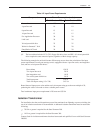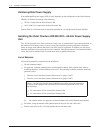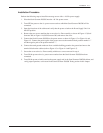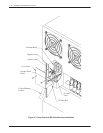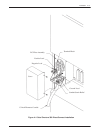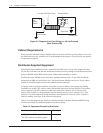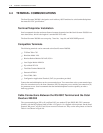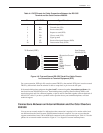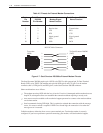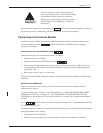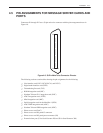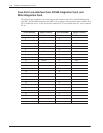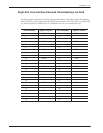
4-16
Installation and Maintenance
Volume
Octel Overture 200/300 Serenade 3.0
PB60014–01
4.4 TERMINAL
COMMUNICA
TIONS
The
Octel Overture 200/300 is designed to work with any ASCII send/receive serial terminal/teleprinter
that meets RS-232C specifications.
Terminal/Teleprinter Installation
Octel
recommends that the maximum distance between the terminal and the Octel Overture 200/300 is no
more than 50 feet, which is the length of a standard RS-232C cable.
The Octel Overture 200/300 uses even parity, 7 data bits, 1 stop bit, and XON/XOFF protocol.
Compatible Terminals
The
following terminals can be connected to the Octel Overture 200/300:
-
TI Silent 700 or 703
-
Hazeltine Model 1410
-
Hewlett-Packard Models 2621A/P
, 2631A
-
Lear Siegler Model ADM-3A
- W
yse Model WY
-50
- TeleV
ideo T
erminal Model 950
-
Panasonic KXD-1
1
-
Falco 5500e, 500e
-
Configuration Applications Terminal (CA
T) (no procedures provided)
Connect the terminal/teleprinter to the system-terminal port. T
wo connections to the system-terminal port
allow for convenient access: the front connection (SP1) for temporary access and the rear connection (J1)
for permanent access. Octel recommends that the terminal/teleprinter have the capability to make a
hard-copy printout.
Cable
Connections Between the RS-232C T
erminal and the Octel
Overture 200/300
The
system-terminal port (SP1 or J1) and Port B (J2) use standard 25-pin (DB25) RS-232C connectors
(female), with the DCE pinouts listed in T
able 4-4. Figure 4-6 is a diagram of these pinouts. On the Octel
Overture 300, ports C and D (J3 and J4) are reserved for future use. They use the same pinouts as listed in
T
able 4-4 and shown in Figure 4-6.




